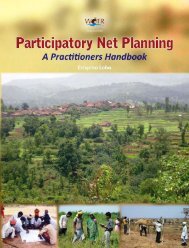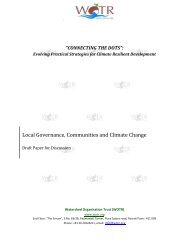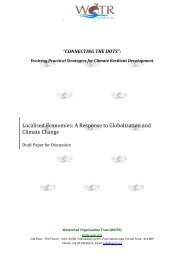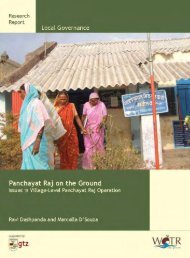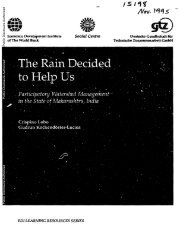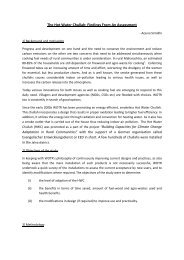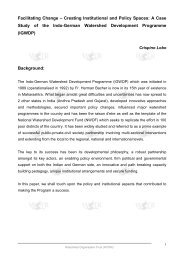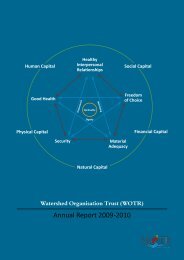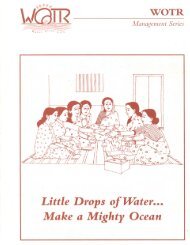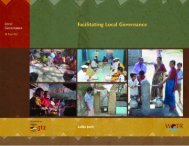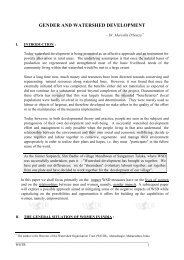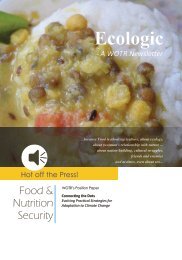Download list, PDF, 117KB - wotr
Download list, PDF, 117KB - wotr
Download list, PDF, 117KB - wotr
Create successful ePaper yourself
Turn your PDF publications into a flip-book with our unique Google optimized e-Paper software.
Films for Sale<br />
Name of Film Language VCD<br />
1 Kadar Mulichi<br />
AnandiSansarachi<br />
2 GavatLaxmiAali<br />
3 RabauPanlot<br />
SukhAlot<br />
4 ApaliPragati<br />
AplyaHati<br />
5 Our School on<br />
the Watershed<br />
6 Enkindled Hope,<br />
Resurgent Spirits<br />
DVD<br />
Time Description<br />
Marathi VCD 34min In Indian rural areas especially female child birth is not a cherish able matter even today. A female, who<br />
makes life worth living and spreads happiness in family and society, is capable of effectively contributing in<br />
financial development of the society as well as plays vital role in giving emotional support especially in crises.<br />
When it matters about the gender partnership, women are always ahead in society. The film “Kadar Mulichi<br />
Anandi Sansarachi “demonstrates this with example.<br />
Marathi VCD 30min “Gavat Laxmi Aali.” An inspirational story of Venubai gives us insight into how Venubai has transformed the<br />
situation with the help of self help Group. This film emphasizes the capability of women to bring economical<br />
as well as social transformation in the society. If proper saving habits are inculcated among established SHGs,<br />
every household can become rich and ultimately entire village could get a face lift.<br />
Marathi VCD 42min The Documentary film “Rabau Panlot sukh A lot” is a wonderful experience to watch, how entire village<br />
unanimously coming together gets resolved to find solution to personal, social ,political and economical<br />
issues of the village. Each villager from every smallest village contributed in rejuvenating of the ecosystem<br />
through Watershed development programmed.<br />
Marathi VCD 22min The documentary “Apli Pragati Aplya Hati “demonstrates us about, what is watershed development? What<br />
are its various components and their relationship with each other? about the watershed area development<br />
process and its various advantages along with the FAQ’s (Frequently Asked Questions)about watershed<br />
development area from the rural areas in details.<br />
Marathi,<br />
Hindi,<br />
English<br />
&<br />
Telagu<br />
English<br />
&<br />
Hindi<br />
VCD 16min The successful implementation of a Watershed Development Program not only improves local water<br />
resources and agricultural activity but also enhances social cohesion, helps in women’s development,<br />
etc..through the ‘watershed plus’ activities. However, in Gunjalwadi, a small village near Sangamner (Dist.<br />
Ahmednagar), Watershed Development directly affected the lives of the students of its school and how! The<br />
school led by its dedicated teachers has revolutionized the concept of ‘hands on’ education with its<br />
enthusiastic students. The students have not only learned about watershed development but have actively<br />
taken part in developing the area around their school. These activities are entirely managed by the students<br />
and they have developed a self sustaining model from funds raised by working on the Watershed Project.<br />
Here is an example for all schools, of how the subject of environment can be taught to students playfully but<br />
effectively and how we can nurture responsible future citizens.<br />
VCD 21min The successful implementation of a Watershed Development Program not only improves local water<br />
resources and agriculture activity but also improves social cohesion, helps the women’s sector, micro finance<br />
etc through the ‘watershed plus’ activities. The self help groups of the women give them a space to come<br />
together, discuss their problems, hopes and work out ways ahead collectively.<br />
For many of the women, the SHG gave them the opportunity to step out of their houses, experience the<br />
world outside their own villages and built up their self esteem and confidence. All these are the steps on the<br />
road to empowerment. This film is the compilation of the experiences of many such women who have found<br />
strength in the unity and solidarity of their groups. While they have come far, they have dreams of taking up<br />
bigger and bigger challenges in the future – with the assured support of their groups.
7 Vaijubabulgaon:<br />
A story of transformation<br />
8 Charaibandi:<br />
A Ban on Free Grazing<br />
9 Garamsur:<br />
10 Dongaon:<br />
U Turn to Fortune<br />
Marathi<br />
&<br />
English<br />
Marathi,<br />
Hindi<br />
&<br />
English<br />
VCD 41min Integrated watershed development brings with it a drastic transformation in the face of a village. It not only<br />
regenerates natural resources, it also brings alive the watershed community who have come together, often<br />
for the first time, to work unitedly for own development.<br />
In VaijuBabulgaon (Taluka Pathardi, District Ahmednagar), despite three consecutive years of severe<br />
drought, the village still had sufficient water for drinking and for their animals. This is their story in their own<br />
words telling of the process they went through, their understanding of the work and the transformation it<br />
brought about in their lives.<br />
The film will serve as useful awareness generation and training material for new entrants into the field of<br />
watershed development wishing to take up similar activities in their own areas.<br />
VCD 39min The ban on free grazing in treated areas, which is one of the ‘non negotiable’ of the watershed program,<br />
holds different meaning for different stakeholders in the program. While it ensures protection of the<br />
treatments undertaken and survival of plantation done, it also adversely affects the herding community, who<br />
are usually the poorest in the watershed, in the form of additional work to cut and carry fodder for their<br />
livestock. The main opposition to this ban on free grazing comes from them. This film makes an attempt to<br />
see the situation from different perspectives. While some of the herders see the advantages of the<br />
watershed program in terms of increased water and fodder which has greatly benefitted them, others just<br />
are not willing to accept that they be made the sacrificial lambs to this developmental initiative which is<br />
supposed to benefit the entire watershed community.<br />
It is very necessary that their needs too, be taken into consideration and sensitive ways forward be found<br />
which are acceptable to all. Once the trees have gained sufficient height, methods like controlled grazing<br />
could be adopted.<br />
English VCD 25min For a village so small, remote and relegated to eternal poverty, one would expect its inhabitants to welcome<br />
the Watershed Programme with open arms. After the all programme brought with it the much needed funds<br />
and employment. Yet the village Garamsur chose otherwise. The ‘power centres’ of the village felt<br />
threatened by this programme which sought to empower common people. Ostensibly, the issue raised was<br />
charaibandi or ban on free grazing, but in reality, the village sought to be divided on caste lines. A group of<br />
dedicated people from the village took up the challenge. They mobilized women’s Self help groups. As the<br />
groups flourished, more and more women joined in, women even from the ‘dissenting’ families. This was<br />
women’s power. The change in attitude came in slowly, but surely. The entire village joined the Watershed<br />
Programme and completed the pogramme before its deadline! This is a moving story of the triumph of<br />
sincerity, hard work and perseverance over village ‘powers’ and certainly of the important role which can be<br />
played by women in bringing about lasting changes.<br />
English VCD 21min Dongaon (TalukaBiloli, Dist. Nanded) was a village divided into two political factions. A rivalary so harsh that<br />
any work involving the entire village community was impossible. A severe drought made the entire village sit<br />
up and think. The only hope was the Watershed Development Programme offered by the Watershed<br />
Organisation Trust, (WOTR). But there was a catch. The watershed programme stipulated the participation of<br />
the entire village. So would the ‘leaders’ bury their hatchet and rise above the rivalary? Would community<br />
spirit win over individual egos? Would Dongaon reverse its (mis) fortunes by embracing watershed<br />
development? The Dongaon Watershed Project was facilitated by SanskritiSamvardhanMandal. ‘Dongaon –<br />
U turn to fortune’ is an important case study for individuals and organizations involved in the development<br />
sector.
11 Shramadaan:<br />
A Labour of Hope<br />
12 Wadgaon<br />
Marathi,<br />
Hindi,<br />
English<br />
&<br />
Telagu<br />
13 Relearning From Reality Marathi<br />
&<br />
English<br />
14 Experiences of VWC<br />
in Maharashtra<br />
VCD 21min The concept of Shramdaan or contribution of labour, has been prevalent for ages. However, most of the<br />
times, we witness that Shramdaan is done to construct a temple or a small village utility. To convince the<br />
entire village to do shramdaan for a developmental project is an immense task, even if the development will<br />
be beneficial to the village, there are problems. These range from traditional notions about Shramdaan to<br />
the downright selfish yet relevant questions, “How will doing Shramdaan benefit me?”. Then there are issues<br />
ranging from politics to spiritual make up of people, landholding patterns to severity of drought, from<br />
government schemes which do not expect contribution, to schemes which expect people’s contribution. This<br />
film attempts to expose yet not analyse, (the analysis is for the viewer to do) the various issues arising in<br />
Shramdaan. It studies examples of various villages, the problems faced by them and solutions found by them<br />
in their unique situations. After all Shramdaan is the first step towards self help.<br />
Marathi VCD 45min While doing retrospection of the progress achieved in the village active villagers cherish their memories and<br />
enjoy the developmental changes occurred at Wadgaon in district Aurangabad, where none of the villagers<br />
knew about even ABC of the Watershed Project. Because of LoksathiPratishtans lead all villagers decided to<br />
implement the Watershed development work in Wadgaon.The film “Wadgaon :KimyaPanlotachi ”<br />
systematically discloses the secret of success of the project.Right from seeking permission from forest<br />
department up to implementation of the project it’s a magnificent experience to watch how this small village<br />
got transformed itself in a progressive one through the watershed work .To <strong>list</strong> some of the advantages<br />
villagers has received out of watershed project are: Ban on alcohol, Repayment of loan, awareness and<br />
confidence building, conscious concretization, increased crop production.<br />
Marathi<br />
&<br />
English<br />
VCD 24min In March 2004, Watershed Organisation Trust (WOTR) in collaboration with the Karl Kubel Foundation,<br />
Germany and the international Foundation for Agriculture and Development, Italy organized an Exposure<br />
and Dialogue Programme (EDP). The EDP which is actually an immersion into the lives of the rural people<br />
This help the participants to get ‘first hand’ experience of the life of the people. This helps them to<br />
understand how people perceive their own situation with respect to natural resources conservation.This<br />
turn helps the policy makers and practitioners formulate relevant and appropriate developmental policies<br />
and strategies. The EDP participants visited and stayed in four villages from WOTR’s implementation area in<br />
Akole region of Ahmednagar district. They had the opportunity to get a first hand idea of life in the village,<br />
how the watershed development effort was implemented and the perception of resulting changes as<br />
experienced by the villagers themselves. This video elaborates on the theme of EDP the learning of the<br />
watershed dwellers and also of the visiting participants. It’s a learning and reflection tool for us too!<br />
VCD 26min In the implementation of a watershed development project, the Watershed Committee has an important<br />
role to play. The more representative, transparent and efficient is the Watershed Committee, the better is<br />
the quality of the watershed work and the overall development of the village. Through its more than ten<br />
years of work, the Watershed Organisation Trust (WOTR) has been able to establish many such watershed<br />
committees throughout the State of Maharashtra. Experiences of Watershed Committee members on<br />
important issues like watershed development, village development, women’s empowerment etc… are<br />
depicted in this video film. Members of the watershed committee have shared their views about the effots<br />
made, difficulties faces, solutions explored, their achievements and also failures.The video explores different<br />
issues and situations, changes that occurred from self centered attitudes to owning social responsibility, the<br />
relationship between natural resources conservation and daily village life, consequences of leadership etc.<br />
The beauty of this video is that the Watershed Committee members themselves are at centre stage. They<br />
express themselves, their new perception, experiences in their own earthy and inimitable style.
15 Chaluya<br />
Swawlambanachhya<br />
Vatrvar<br />
16 Ridge to Valley Marathi,<br />
Hindi<br />
&<br />
English<br />
17 Water Gives Life Marathi,<br />
Hindi<br />
&<br />
English<br />
Marathi VCD 40min In India, where Poverty, drought Loan, migration being a long tell, the message that, Nothing on this Earth<br />
can stop women when she decides to transform the situation, is well conveyed through the film “Chaluya<br />
Swawlambnachya Vatevar”.The film begins with women’s decision to step out of house and form SHGs<br />
through which they discover and share new things. While supporting each other, this is just the beginning of<br />
their long voyage towards self reliance. Creating various Savings source as a substitute for the moneylenders<br />
to avail loans might be the first step toward this journey.This entire process of building SMS benefits the<br />
village women in many dimensions /aspects. Through this women not only learn to solve their problem<br />
fearlessly at their end but also they very well understand that coming together might prove helpful in<br />
solving their problems related to village development and also give them courage to face social inequality.<br />
No doubt women had taken a big leap towards Self Help though miles to go yet…….WOTR had been always<br />
besides these women through the journey.<br />
VCD 22min Our environment is progressively getting degraded because of overexploitation of natural resources. In a<br />
degraded landscape with little or no tree cover, and subsequently little soil cover, rainwater is not able to<br />
percolate into the ground. We lose rich top soil with this running water, which flows away into the streams.<br />
It is a vicious cycle – no top soil, no vegetation, increased run off of water and further erosion of top soil.<br />
Ho<strong>list</strong>ic watershed development is the answer to break this vicious cycle.This video film explains the<br />
importance of the ‘Ridge to Valley’ approach. It explains the various area treatments in non-arable waste<br />
land, cultivable land and also speaks about drainage line treatments. This video film highlights the technical<br />
and social components and the reasons why watershed work should start from the ridge and progress<br />
downwards towards the valley.<br />
23min ‘Water gives Life’ is an attempt to understand the importance of natural resource management through<br />
Watershed Development for creating sustainable livelihood opportunities for poverty alleviation.<br />
This film focuses on the importance of community participation in resource conservation and management,<br />
since it is the concerned community, which is in constant interaction with their environment. The ownership<br />
of the project by these stakeholders is a precondition for its success and sustainability. The film also looks<br />
into the principles of the watershed management and its impacts.<br />
This film draws upon the experiences and works of Watershed Organisation Trust, (WOTR) / Indo-German<br />
Watershed Development Programme (IGWDP)<br />
18 The Silent Unfolding English DVD 20min In 1996, a weary, drought ravaged Darewadi, turned towards Watershed Development as a last resort. They<br />
had not much to lose, for they had lost nearly everything to the devastating drought which had an extended<br />
stay in that region.The Watershed Development project implemented by the Watershed Organisation Trust<br />
(WOTR) Ahmednagar was completed by 2002. Since then Darewadi has never looked back.WOTR has a few<br />
hundred successful ‘Darewadis’ in its ever growing portfolio of projects. Projects which aim at eradicating<br />
rural poverty by regenerating the environment and addressing developmental issues in rural areas in a<br />
professional, no-nonsense approach.<br />
‘The Silent Unfolding’ is not just about the transformation of one village. It is about the philosophy and<br />
approach adopted by WOTR which is creating a silent revolution, a movement by the people themselves for<br />
their development and progress.
19 Swarajyachya<br />
Watevar<br />
Marathi<br />
&<br />
Hindi<br />
VCD 28min The growth and Prosperity of any Country is relatively dependant on overall development of the villages of<br />
that country. The term village development means natives control on the local resources. After<br />
implementing such independent system ownership should remain with the native people this is the most<br />
important idea behind this. The film: Swarajyachya Vatever tells us about the local leadership and the<br />
process of establishing the organization.<br />
How to ensure maximum representation and participation from each class/level in the society to serve<br />
primary needs of the village in a better way is demonstrated in the film. When villagers by taking initiative,<br />
willingly accept responsibility of village development then only they set for journey towards self reliance.<br />
WOTR had been giving continuous support to the villagers in their efforts during this voyage.<br />
20 The Story of Painting English DVD 14min This docu-drama has been filmed in Naralewadi (Dist. Jalna, Maharashtra) where WOTR has implemented<br />
Renewable Energy based technologies such as biogas plants, solar LEDs, etc. The intervention was made to<br />
stop traditional fuel consumption in the village (fuel wood, kerosene lamp, cow dung, etc.) which has been<br />
adversely affecting the health of the inhabitants and their ecosystem. The impact and the transformation<br />
following this project have been brought out in this film through Rama’s painting….<br />
21 Damalwadi&Wazar<br />
(Safe drinking water<br />
project)<br />
22 Khadkipada:<br />
A tale of development an<br />
account of<br />
transformation<br />
23 Pirewadi:<br />
A story of Success<br />
24 Jambhore:<br />
Try again and you will<br />
succeed<br />
25 Mohane:<br />
A new thought!....<br />
a new direction!<br />
26 Kholvihir:<br />
A green transition<br />
Marathi<br />
&<br />
English<br />
Marathi<br />
&<br />
English<br />
Marathi<br />
&<br />
English<br />
Marathi<br />
&<br />
English<br />
Marathi,<br />
Hindi &<br />
English<br />
Marathi<br />
&<br />
English<br />
VCD 25min Damalwadi and Wazar were two drought prone villages of Maharashtra, where availability of drinking water<br />
was a perennial problem. The women were the most affected by this. The requirements to implement<br />
WOTR’s clean and safe drinking water project’ were do able yet challenging.<br />
This short film tells the story of how the Samyukt Mahila Samiti (Apex Body of Women’s Self Help Groups)<br />
challenged tradition and together resolved the water issue.<br />
VCD 24min This is the story of the journey of a tribal village, from darkness towards the light.<br />
Distress migration, indebtedness to money-lenders, ill health and illiteracy was a way of life. All seemed<br />
hopeless! The scenario changes with a self help effort facilitated by WOTR<br />
Caring for the land that they once exploited suddenly brings in the returns. The well water level rises, land<br />
becomes more productive, horticulture is introduced and there is a reason to stop the migration. Women<br />
too find a space to come together meaningfully. Now they see a ray of hope!<br />
VCD 28min Pirewadi in the Newspapers<br />
“The determination of the Pirewadi people ….A friendship with WOTR”<br />
“Pirewadi villagers anxiously await the rains”<br />
VCD 38min The inhabitants of Jambhore, a small tribal village in the Dhule district are mainly engrossed in festive<br />
activities. Surviving on the natural resources of their village, they are oblivious of the depletion of these<br />
resources. They are unaware of the potential they have to resolve these issues. When WOTR enters the<br />
village, only difficulties seemed to surface.<br />
VCD 26min Four tiny tribal hamlets each struggling to survive independently<br />
WOTR sees that they all belong to one watershed. Is there a way of bringing them together?Would they be<br />
prepared to come together?<br />
VCD 27min Impact of Watershed work. Facts for year 2000 & 2006<br />
Water column 28 feet from surface -> Well water column 15 feet from surface.<br />
One rainfed crop -> Two and sometimes three (irrigated) crops<br />
Distress migration -> Work within the village<br />
Money-lenders thrive-> Women’s SHGs addressing small needs<br />
Low levels of education / literacy -> Increase in school attendance<br />
Unavailability of safe drinking water ->Potable tap water in each house
27 Pangra Marathi<br />
&<br />
English<br />
28 Tamkadwadi Marathi<br />
&<br />
English<br />
29 The Rain Trappers English<br />
&<br />
Hindi<br />
30 Sowing Seed Of<br />
Empowerment<br />
Marathi<br />
&<br />
English<br />
31 My Place Under The Sun Marathi<br />
&<br />
English<br />
32 We Help Ourselves Marathi<br />
&<br />
English<br />
VCD 18min ‘Obstruct the soil and let water seep in’ was the slogan to revive the environment. Multiple cropping was<br />
now possible for the farmer due to the improvement in agriculture. There was an increase in well water<br />
level where water is now sufficient throughout the year. Farmers are using this water judiciously. Since<br />
Labour is now available in the village villagers are not migrating to other villages for sugarcane cutting.<br />
School going children are not deprived of their education. The percentage of school attendance is now<br />
increased. Pangra village is now showing development in all aspects like health, education and cleanliness.<br />
Environment and next generation is getting a rejuvenating lift.<br />
VCD 12min Tamkadwadi is a village which lies in the mountainous region at the Nasik districts of Maharashtra. Initially<br />
this village was recognized as a drought prone area with huge water shortage. The villagers had to depend<br />
on tankers for drinking water for 4 to 5 months a year………….The watershed development program has<br />
helped the villagers improve their financial condition. Availability of sufficient water in the wells, increase in<br />
the agriculture yield, formation of self help groups to give an ensure to their financial problem and the well<br />
fed fields personify peace and harmony in the village<br />
DVD<br />
&<br />
VCD<br />
15min Watershed Organisation Trust, (WOTR), was established in 1993 in Ahmednagr, Maharashtra. The aim of<br />
WOTR is to support village communities in eradicating their poverty by regenerating their environment<br />
through watershed development. To achieve this objective, WOTR, together with its partners, seeks to<br />
mobilize the creative potential of the watershed dwellers making this a people’s movement. WOTR also<br />
assists NGOs and other VSHGs interested in watershed development by extending them support to build up<br />
their capacities.<br />
Today WOTR has come a long way from its specialization – trapping Rainwater. WOTR has programs for<br />
children, women, non-conventional energy and micro-finance through Sampada Trust, its sister concern.<br />
VCD 24min The film is based in Nandurbar and Dhule region, Famous for its red chillies; it is a district with highest tribal<br />
population in Maharashtra. WOTR’s sister nonprofit Sampada work’s along with the women here to<br />
encourage savings. The women self help group procure and distribute seeds to the women. A kitchen garden<br />
in the backyard is the key to self reliance, saving as well as nutrition and health. Women tasted self reliance.<br />
Women in Runmali were divided along caste lines. Once they got together, they challenged all old beliefs,<br />
including that banking was a man’s job. They supported each other in giving loans in sickness to extending<br />
credit for a beauty parlours enterprise. Once inspired, the survival became a success story.<br />
VCD 24min Amravati district is the orange growing country. The women do not experience poverty, but they also have<br />
no sense of identity. The film captures their spirit to discover themselves, by the self help groups. Dressed in<br />
a sari, heads covered rushing around to get things done. Renting loudspeakers, to cooking vessels to keep<br />
the money coming. Women in Wardha district are not only being seen in public life, but they are also being<br />
heard. They took initiative to organize a Self Respect rally on issue of farmers committing suicides, recently<br />
they see development in a new light by getting Solar lights, a toilet and dignity in each home. They have set<br />
up a separate, independent Gram Sabha of Women. Their applications are now taken seriously in<br />
Government offices. Way to go women rules your world.<br />
VCD 28min The migrants from Beed and Ahmednagar region, the sugarcane cutters may add sweetness to many lives.<br />
They are bitter about migrating. Sampada has touched the lives of 2100 women. The men made disparaging<br />
remarks, until women resolved to prove themselves. They stepped out in the night, if need be to conduct<br />
their business meetings. They got drinking water in the village of Parchundi. Women have started taking<br />
their own decisions and solving their own problems. With their individual development, they have also<br />
started thinking of the village development also. Their journey has begun on the path of progress.
33 Rise Of the New Dawn Marathi<br />
&<br />
English<br />
34 Purushwadi Marathi<br />
&<br />
English<br />
35 On the path of the<br />
Prosperity<br />
36 Participatory Net<br />
Planning:<br />
A tool for People’s<br />
Involvement and<br />
Sustainability<br />
37 Wasundhara<br />
New vista…<br />
New Direction…<br />
38 Sahaav -<br />
A collaborative<br />
Watershed Development<br />
experience…<br />
Marathi<br />
&<br />
English<br />
VCD 15min Women are the care providers, of all but their own self. The women empowerment program in 150 villages<br />
is about realizing their true potential. With Sampada Trust, they receive training in entrepreneurship to<br />
manage small scale businesses from selling bangles to dried fish, to preparing manure and selling it. It is the<br />
Self – Help groups that make the difference, in their confidence levels. As a collective group their outshine<br />
darkness all around them. It is like “The lamp is mine but the light is ours”<br />
VCD 14min A Tale of a Village. The face and fate of the tiny hamlet of Purushwadi in the Sahyadri mountain ranges has<br />
changed completely thanks to the Watershed Development Programme. Success of the program can be<br />
attributed to the villagers participation in watershed related activities under the guidance of WOTR. Now<br />
that the balance of forest, soil and water has been restored the nature is blossoming in the village again.<br />
VCD 31min ‘On the Path of Prosperity’ documents the vivid transformation in the lives of the villagers of Hiware and<br />
Chimthalwal in Maharashtra brought about due to the implementation of watershed activities initiated by<br />
WOTR. While it explains the process of watershed development through its two phases of capacity building<br />
and execution, it also focuses on how the ground reality of the villages changes from barren and infertile<br />
patches of land to fertile regions capable of producing up to two crops a year. Alongside watershed<br />
development there takes place related progress through the empowerment of women, the setting up of self<br />
help groups and health care. It also highlights the importance of voluntary labour (shramdaan) that<br />
ultimately helps in leading the villages to a status of self sufficiency and even prosperity.<br />
Both Hiware and Chimthaval have experienced reverse migration and witnessed a leap in entrepreneurship<br />
because of watershed projects. Visually captivating, the film also includes firsthand accounts of farmers and<br />
enterprising women whose lives have undergone a tremendous change for the better.<br />
English VCD 15 Participatory Net Planning (PNP), developed by WOTR in 1995, is today a well known and widely adopted<br />
methodology for the planning and implementation of participatory watershed development projects in India.<br />
PNP is a gender inclusive methodology that actively engages stakeholders in the development and<br />
management of their land and common resources. This film gives an over view of the philosophy and<br />
approach of the PNP methodology as well as provides a step by step outline of how PNP is actually done in<br />
the field. A software package that greatly facilitates preparation of a Net Plan is also available at WOTR.<br />
Hindi<br />
And<br />
English<br />
Hindi<br />
&<br />
English<br />
DVD 45 min WOTR’s Wasundhara Guidelines and its various successful facets was an ideal methodology to take up the<br />
challenge of breaking into new territories of Madhya Pradesh for the WOTR team. For this, we chose 8<br />
villages from 3 districts of Madhya Pradesh. Community organisation, capacity building, engendering full,<br />
institutionalized participation of the people into the various aspects of Watershed Development were some<br />
of the key noteworthy features of the project. The success is reflected in how this is now established into an<br />
institutionalized framework and has become a way of life in these 8 villages.<br />
This film traces the beginnings, follows the project implementation in its entirerity and tells the story of<br />
these experiences that can go towards strengthening initiatives for empowering villages not only in Madhya<br />
Pradesh but also in the many villages of India.<br />
DVD 32min Sahaav is the story of 3 villages- Partala, Dungariya and Katangi- 3 villages in Mandla district, Madhya<br />
Pradesh and their journey of transformation. Under the WOTR-Wasundhara program, the community came<br />
together and turned their impoverished migration to ho<strong>list</strong>ic, green prosperity.<br />
The WOTR-Wasundhara program combining socio-economic empowerment with Watershed development<br />
has managed to break the vicious cycle of land degradation, water scarcity, poverty and migration and other<br />
associated issues typical to most rural communities today. Through this multi-faceted program, ecosystem<br />
rejuvenation and social cohesiveness come together to bring about positive change.



